|
REGISTRATION REQUIRED
refurbishment
 How do you know when your exhibit is truly on its last legs? Industry experts weigh in, providing a step-by-step guide to the end-of-life decision-making process. By Linda Armstrong
It's usually easy to determine when something has one foot in the grave. Everything from daisies to honeydews to dear old Boo-Boo Kitty pretty much tells you when it's "time." Exhibits, however, aren't quite so obvious.
The general rule of thumb is that you'll get three to five years of use from a booth. But what if your marketing strategy does a 180, or your CMO wants to overhaul the brand shortly after a new build? Or perhaps your booth still works, but it's 7 years old – a geezer according to industry averages. When rules of thumb don't apply, how do you determine whether to keep your exhibit, refurbish it, or simply put it out of its misery? For answers to these questions and solutions to other end-of-life concerns, EXHIBITOR tapped a handful of industry experts for advice. Including a step-by-step decision-making strategy, their suggestions can help you determine whether you should resuscitate or exterminate your company's ailing exhibit. 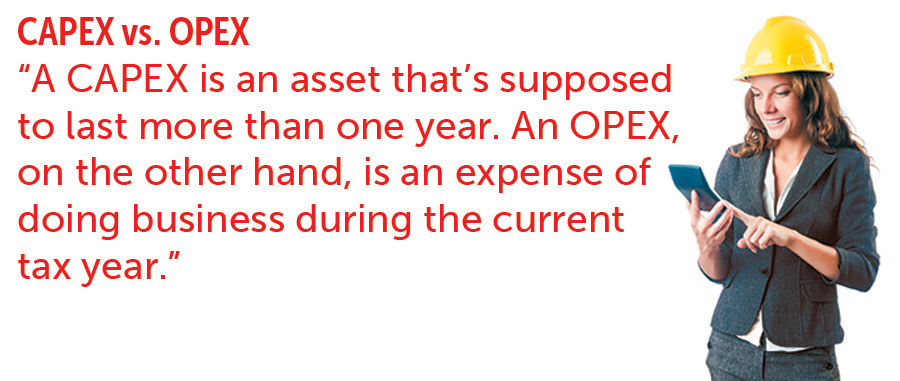 If you suspect your exhibit is about to expire – perhaps it's showing its age, is off trend, or is simply out of synch with your marketing objectives – your first step is to investigate the financial ramifications of scrapping it. After all, there's no point in analyzing your exhibit's condition and considering alternatives if your company's financial situation makes any type of change impractical or outright impossible. To check your financial pulse, Steve Deckel, vice president at Deckel & Moneypenny, an exhibit house in Louisville, KY, suggests you first contact your accounting department to determine if your booth is a capital expenditure (CAPEX) or an operating expense (OPEX). "A CAPEX is an asset that's supposed to last more than one year. An OPEX, on the other hand, is an expense of doing business during the current tax year. An OPEX is fully deducted from your company's taxes the same year you purchase the stand, and a CAPEX is capitalized and deducted over the course of several years. Bottom line: If your booth is an OPEX and has already been deducted, you can build new, rent, or refurbish without negative tax consequences. But if it's a CAPEX that hasn't been fully depreciated, you'll likely need to make strong arguments with your accounting department and internal stakeholders as to why this investment – and loss of the undepreciated value – is necessary." If your exhibit, like most, happens to be a CAPEX, also ask your accountants for the exhibit's Net Book Value, says Stephanie Chavez, marketing director at The Trade Group, a Carrollton, TX, exhibit house. "Net Book Value is the initial cost of the exhibit minus depreciation," she says. "For example, if you purchased an exhibit for $100,000, and its depreciation thus far is $70,000, you have a $30,000 Net Book Value." This information can then help you decide not only if you should make dramatic changes with your stand but also what course of action you should most likely take. That's because Net Book Value is kind of like the Blue Book Value of a used car. If your car is only worth $2,000, you shouldn't put $4,000 of repairs into it, and you probably shouldn't outright trash the vehicle unless it stops working and nobody wants to buy it. Similarly, if your exhibit has a $30,000 Net Book Value and you can refurbish it to better meet your objectives for less than $30,000, that's probably the best option financially. "But, if it costs more than $30,000 to refurbish, it might make more financial sense to cut your losses, scrap your current booth, and buy new or rent," Chavez says. As long as you've got the attention of your accounting department, Jeannine Swan, president of Global Exhibit Management, suggests you investigate budgetary timing. "If you're in the middle of a fiscal year and budgets have already been set, there is probably no money available for a new exhibit," she says. If you don't know when budgets are allocated, get a long-term schedule to determine when it would be most feasible for you to add a new build to the calendar. Then secure an estimate of how much money might be at your disposal. If accountants can't offer predictions, look for historical records to see what was spent on such endeavors in the past, as well as how frequently your company has purchased or refurbished exhibits. This precedent can give you a rough idea of what might be possible moving forward. Once you've gathered info from internal sources, get some ballpark figures from your exhibit house. This isn't the start of a request-for-proposal process, and you're not locking into using your existing firm should you choose to buy a new booth. Rather, you merely need rough estimates to help you determine feasibility before you invest more time into the decision-making process. So contact your account executive and explain your reasons for considering a new booth. Then ask him or her roughly how much it'd cost to build a new stand with the footprint and features you want, what it would take to rent a structure, and how much you'd spend to refurbish your existing exhibit to meet those demands. Again, you're looking for ballpark figures and ranges, not line-item breakdowns.  STEP 2: Scrutinize Your Existing Stand After completing step one, you should know whether a new exhibit, refurbishment, or rental program is really feasible. But just because you can buy doesn't mean you should. Your second step is to analyze your existing structure, determine whether a change is truly necessary, and develop some initial ideas about what direction those changes might take. To complete step two, you must first understand your marketing objectives. So get crystal clear about what you need and want with regard to everything from branding opportunities and storage space to product displays and technology integration. Next, Chavez suggests you examine the "bones" of your stand just as a home buyer analyzes a new house. Does it have the potential to meet your current and future needs, requiring only reconfiguring or reskinning components? Or is the construction so far off the mark that only a can of gasoline and a match can rectify it? For example, can the structure accommodate the type of conversations and presentations that you hope to have? Does it – or could it – offer the meeting rooms, lounge areas, theaters, demo kiosks, etc. that your current marketing strategy requires? Can it address your program's messaging demands, which might include the ability to incorporate changeable text, messaging hierarchies, overhead signage, etc.? Can you update the look and feel going forward, allowing you to stay on trend in terms of technology, experiences, colors, and materials, or are you pretty much stuck with what you have? And can your bones tell the type of brand story you want to deliver? 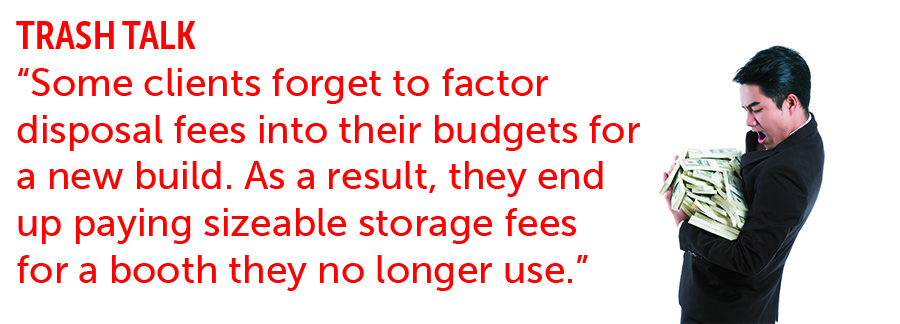 Deckel suggests that you complete a thorough cost of operation (COO) analysis. Examine all of your annual costs and analyze ancillary fees, such as shipping, installation-and-dismantle labor, drayage, and graphic updates. Would a change in your booth's weight and/ormaterials make a sizeable enough dent in those fees to warrant a new exhibit? "Also consider your storage costs," Chavez says. "A big,bulky booth that can't be broken down into smaller parts will cost you more to store and transport." By building new, even if you have a decent Net Book Value, you might save money in the long run if you're able to decrease those costs. So ask your exhibit house to do a line-item comparison between your current exhibit and one made with components or materials that could lower your COO. Then run the numbers to determine your savings over time. A new booth might just pay for itself and provide a solid argument for trashing the old one. 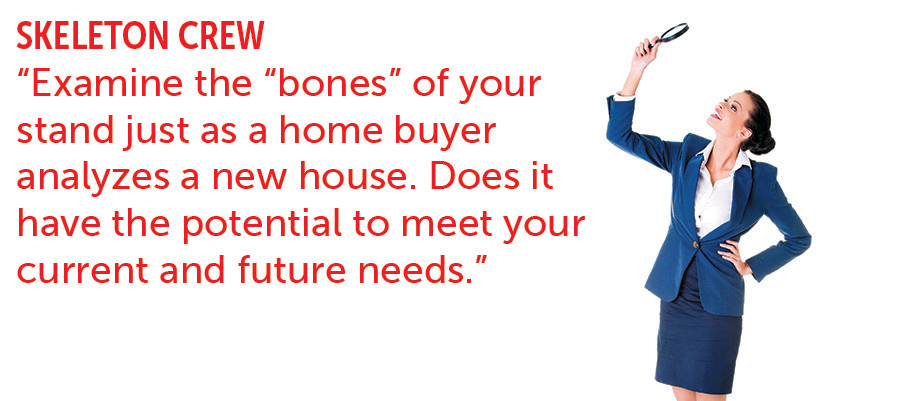 If you plan to use this booth only a handful of times over the next few years, it might be best to refurbish it, since you don't want to dig deep into your pockets for a booth that'll sit in storage for most of its life. But if the exhibit will be used again and again – and can be reconfigured for multiple footprints – it may be advantageous to build new, particularly if you stand to incur logistical savings via lighter materials and less-bulky exhibitry. 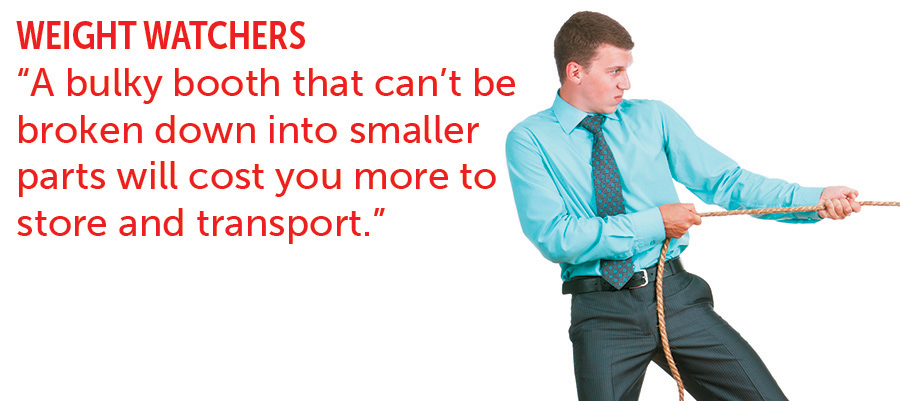 By now, you should have a decent idea of whether you need and can afford a significant change in exhibit structures. If all indicators point to change, your next step is to determine what that evolution will look like and entail. Do you need a completely new booth or a total refurbishment, or are you thinking about shifting to a rental program or even creating an old/new hybrid, where you keep some of your existing components and marry them with new and improved elements? To best answer those questions, sources propose you complete a full-on exhibit assessment with your exhibit house to decide which route, if any, is best.
NEAR-DEATH DECISION-MAKING
To prepare, gather all of your reports regarding your current objectives and the exhibit's shortcomings. Make special notes about specific deficiencies, such as a lack of reconfigurability, lengthy setup times, in-booth traffic jams, etc., and identify favorite elements you can't live without. Then assemble all assets that still exist from the original build, such as CAD assembly drawings, photos, material specs, crate manifests, lighting designs, etc. In effect, collect anything and everything related to what you want and don't want, what you might want to reuse, and whatever information you or the exhibit house might need to sell or rent your exhibit. During your meeting, present the information and ask your rep to analyze the pros and cons of the following four options.How do you know when your exhibit is past its prime? You perform these three simple steps to diagnose ailments, prescribe solutions, and possibly make end-of-life plans. Step One: Gather Financial Facts Before your try to assess your exhibit's ailments and ascertain possible cures, it's critical that you address your financial situation to determine if any kind of change is feasible. ➤ Determine if the booth is a capital expenditure (CAPEX) or an operating expense (OPEX). With an OPEX you can pretty much do as you wish with your existing stand. A CAPEX involves depreciation over time, and discarding a booth before it's fully depreciated could have negative tax consequences. ➤ Ascertain the exhibit's Net Book Value. Generally speaking, refurbishments shouldn't cost more than the booth is worth. ➤ Assess fiscal budgeting timelines and historicals. ➤ Request ballpark budgets from your exhibit house, including estimates for building new, renting, and refurbishing. ➤ Inquire about exhibit-house booth-disposal fees. Step Two: Scrutinize Your Existing Stand If step one indicates that a change is financially possible, carefully consider what you want to alter about your stand and what directions those changes might take. ➤ Revisit your marketing objectives and update your current list of needs and wants. ➤ Examine your stand as it relates to your objectives. Does it, or could it, meet your demands with modifications? Do you need a whole new booth, or might a refurbishment suffice? ➤ Complete a cost of operation (COO) analysis to determine whether costs such as transportation, drayage, graphic updates, etc. are manageable or exorbitant. Consider whether a new structure could save money by decreasing COO fees. ➤ Analyze your long-term exhibit requirements and your stand's ability to adapt to your demands, as well as ongoing graphic and technology upgrades. Step Three: Run the Numbers If it seems like your exhibit needs a reboot, or it's clearly headed for the scrap heap, assess the following options. New Build – Secure both a new-build estimate as well as your existing structure's rental and buyback options. Investigate all disposal methods and associated fees. Refurbishment – Determine which elements can be refurbished and at what cost. Factor in cost savings accrued from replacing heavy components with new lighter-weight options. Rental – Examine and price-compare rental programs. Hybrid Solution – Consider whether a combination of the aforementioned options might best fit your needs. ➤ 1. New Build – A new exhibit will almost certainly bring in the most revenue for the exhibit house, so your rep may initially steer the conversation in that direction. And that's perfectly fine as long as you eventually talk about all other options. But as the rep prepares additional new-build estimates (which are over and above the range and the line-item COO comparison you asked for in step two), sources suggest you also inquire about the current value of your existing structure and the rental and buyback options the firm can offer. If the exhibit house is willing, you may be eligible for a trade-in discount on a new booth.  In addition, the exhibit house may need to remove certain components, such as electronics, appliances, batteries, fluorescent bulbs, and more, and transport them to special recycling centers for disposal. Or it may deconstruct everything to remove recyclable components such as aluminum and various types of plastic. Not surprisingly, this added labor can tack on an additional expense. At this point, also investigate other disposal options that don't involve your exhibit house: donating your exhibit to charity, selling it yourself or through a third-party site such as LuckyExhibits.com, or reusing components within your organization. You may be able to completely eliminate or at least decrease exhibit-house disposal fees. So before you finalize any decisions, make sure you have a clear picture of what options are available, what's involved in disposal, and how much each option will cost. 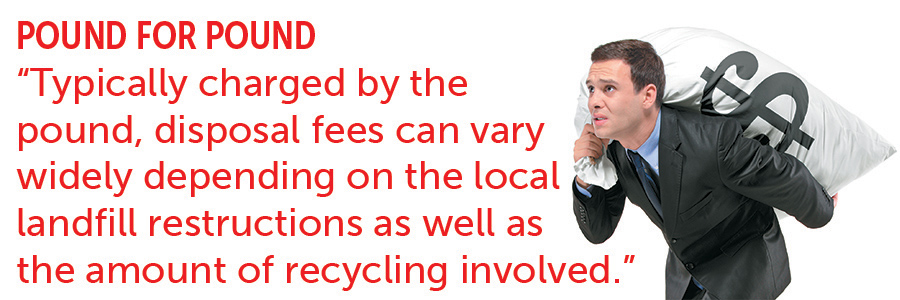 Also consider the long-term expenses associated with refurbishing heavy or bulky materials. "Weighty wooden structures, for example, could be repainted or refinished quickly and affordably," says Matthew Bellin, vice president at Showcraft Inc., an exhibit house in Burnsville, MN. "But you're probably better off replacing those cumbersome structures with something that's lighter weight and breaks down easily, as doing so can significantly decrease weight- and space-related fees such as transportation, drayage, and storage." As you ponder refurbishment, Falberg cautions that you factor in the potential cost of new crates. "Custom crates are designed to fit perfectly around your components," he says. "So if you change the size of any elements, even something as minute as increasing the thickness of your laminate, your existing crates may become useless." ➤ 3. Rental – "Rentals have come a long way in the last decade," Chavez says, "and many exhibit houses can customize their rental inventories for your company, as well as individual shows and target markets. A rental program can also offer the flexibility to 'go big' at some shows and scale it down at others. And, of course, you can try out a configuration or footprint without committing your strategy and budget to it long term." Ask your exhibit house for info and pricing on its rental capabilities. But if renting isn't its forte and its inventory is limited, don't let that stop you from considering this option. Expand your search beyond that firm if necessary. 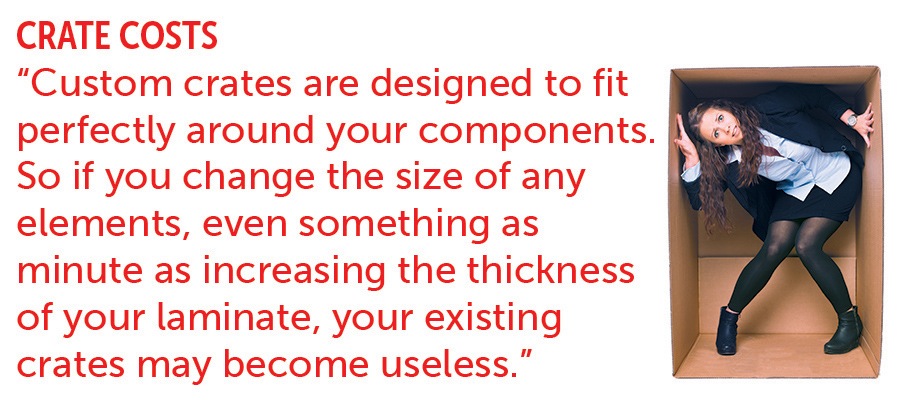 "Rarely do our customers completely dispose of an entire exhibit," Bellin says. "Instead, with new skins, laminates, and graphics, along with the replacement of a few rented or purchased components, we can develop an exhibit that looks and functions like an entirely new booth – often at a cost that is substantially less than that of a new build." If this sounds plausible, request that your account executive flesh out the scenario and determine what, if any, existing components could be reused, which you'd need to buy or rent, and approximately how much all of it might cost. While this three-step process may seem a bit arduous, the required conversations with your exhibit partners should also help you ascertain each firm's willingness and ability to assist you going forward. "It's important to know if your exhibit house is only interested in a new build, or if it can be equally invested in refurbishment and cost-effective disposal options," Deckel says. "If it's laser focused on a new booth, you may want to broaden your own focus to include other firms more concerned with your objectives." Arduous or not, this process should arm you with oodles of information to determine whether you're right to resuscitate your existing exhibit, or if pulling the plug might be the more appropriate option. E
THROW OR NO?
When you're deciding whether to keep or discard your existing booth, it's often helpful to understand what materials can be easily reused and recycled and which ones you'll likely need to completely abandon. Steve Deckel, vice president at Deckel & Moneypenny, an exhibit house in Louisville, KY, offers this list of common exhibit materials and their reuse recommendations. Carpet: Exhibitors often discard their carpet, but it can actually be repaired for continued use. If it's heavily stained or is showing wear, you may still be able to donate parts or all of it to charity. Plus, exhibit houses will often take it off your hands and use it as extra padding inside exhibit crates. Fabric: Fabric, which is lightweight, flexible, and generally easy to produce and transport, can often be cleaned and even redyed. But if torn, it's fairly difficult to patch, and it's nearly impossible to reprint graphics. Florescent Bulbs: Florescent bulbs contain mercury, which is toxic and must be disposed via a hazardous-waste program. If you haven't already done so, trade all florescent lamps for more energy-efficient and eco-friendly options, such as LEDs, which have come down considerably in price as of late. Gas-Filled Plasmas and Monitors: The gas inside these items is hazardous, so you must use a hazardous-waste program in order to dispose of them. Laminate: Laminate can chip and crack easily, but you can relaminate walls, counters, and more. That said, if the element it's covering is heavy, you may be better off swapping it out for a lighter material instead of relaminating its exterior. Metal: Generally speaking, you can reuse or repaint most metals. However, it may be difficult to hide structural blemishes such as gouges, dings, and dents. Modular Aluminum: Unless it has suffered structural damage, aluminum is easy to reuse and recycle. Plexiglas: Given its propensity to scratch easily, Plexiglas is rarely reused. However, Plexiglas can be recycled along with various other plastics. Wood: It's easy to repaint and resurface wood. But given its weight and rigidity – which can increase storage, transportation, and drayage costs – you may want to consider trading your wooden structures for lighter options such as aluminum.
|
|
|
||||||||||||||||||||||||||||
|
|
||||||||||||||||||||||||||||
|
TOPICS Measurement & Budgeting Planning & Execution Marketing & Promotion Events & Venues Personal & Career Exhibits & Experiences International Exhibiting Resources for Rookies Research & Resources |
MAGAZINE Subscribe Today! Renew Subscription Update Address Digital Downloads Newsletters Advertise |
FIND IT Exhibit Producers Products & Services All Companies Get Listed |
EXHIBITORLIVE Sessions Exhibit Hall Exhibit at the Show Registration |
ETRAK Sessions Certification F.A.Q. Registration |
EDUCATION WEEK Overview Sessions Hotel Registration |
CERTIFICATION The Program Steps to Certification Faculty and Staff Enroll in CTSM Submit Quiz Answers My CTSM |
AWARDS Exhibit Design Awards Portable/Modular Awards Corporate Event Awards Centers of Excellence |
NEWS Associations/Press Awards Company News International New Products People Shows & Events Venues & Destinations EXHIBITOR News |
||||||||||||||||||||
|
||||||||||||||||||||||||||||






